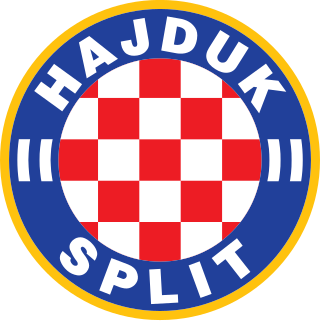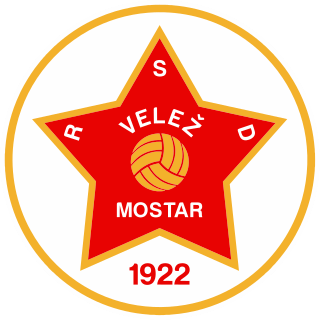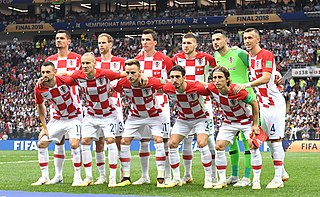
The Yugoslavia national football team represented Yugoslavia in international association football.

Hrvatski nogometni klub Hajduk Split, commonly referred to as Hajduk Split, is a Croatian professional football club based in Split, that competes in the Croatian First League, the top tier in Croatian football. Since 1979, the club's home ground has been the 33,987-seater Stadion Poljud. The team's traditional home colours are white shirts with blue shorts and blue socks.

The Serbia men's national football team represents Serbia in men's international football competition. It is controlled by the Football Association of Serbia, the governing body for football in Serbia.

The Croatian Football Federation is the national governing body of football in Croatia. It was originally formed in 1912 and is based in the capital city of Zagreb. The organisation is a member of both FIFA and UEFA, and is responsible for overseeing all aspects of the game of football in Croatia. The current president of HNS is Marijan Kustić.

Ivan Osim, best known as Ivica Osim, was a Bosnian professional footballer and football manager. He is widely regarded as one of the greatest Bosnian football managers of all time and as one of the most influential football managers in the former Yugoslavia.

Maksimir Stadium is a multi-use stadium in Zagreb, Croatia. Named after the surrounding neighbourhood of Maksimir, it is one of the largest stadiums in the country with a current seating capacity of 25,912 and a maximum possible capacity of 35,423. It is the home stadium of Croatian club Dinamo Zagreb and has been used since 1990 by the Croatia national football team for the majority of international competitions.

Dražen Ladić is a Croatian professional football coach and former player who is the current assistant manager of the Croatia national team.
The Dinamo Zagreb–Red Star Belgrade riot was a football riot which took place on 13 May 1990 at Maksimir Stadium in Zagreb, SR Croatia, then part of SFR Yugoslavia, between the Bad Blue Boys and the Delije. The incident took place just weeks after Croatia's first multi-party elections in almost fifty years in which the parties favouring Croatian independence had won the majority of votes. The riot resulted in over sixty people wounded, including some stabbed, shot or poisoned by tear gas.

HŠK Građanski, also known as 1. HŠK Građanski or fully Prvi hrvatski građanski športski klub, was a Croatian football club established in Zagreb in 1911 and dissolved in 1945. The club had a huge influence on the development of football in Croatia and Kingdom of Yugoslavia and achieved its greatest success in the period between the two World Wars.
The 1990–91 Yugoslav First League season was the 45th season of the First Federal League, the top level association football competition of SFR Yugoslavia, since its establishment in 1946. The title was won by Red Star Belgrade, the club's 18th in its history. It also turned out to be the last season in which teams from SR Croatia and SR Slovenia participated. In 1991, these states left Yugoslavia and created their respective leagues.

Fudbalski klub Velež Mostar is a professional football club based in Mostar, Bosnia and Herzegovina. The club has a history of being one of the most successful clubs from Bosnia and Herzegovina. It was founded on 26 June 1922. The club currently plays at Rođeni Stadium, but its historic stadium is the Bijeli Brijeg. Due to the divisions between Bosniak and Croat territories, Velež lost its previous home ground of Bijeli Brijeg. That stadium was largely used by Velež during the glory days of the club, when they triumphed in the 1981 and 1986 Yugoslav Cups. The club also reached the quarter-final stage of the 1974–75 UEFA Cup. Velež have a bitter rivalry with city neighbours, HŠK Zrinjski Mostar.
The First League of Yugoslavia's 1991/1992 season was the 64th edition of the Yugoslav First League, the premier football club competition of SFR Yugoslavia. It was the last edition in which professional football teams from SR Bosnia and Herzegovina and SR Macedonia participated, as well as the last of the SFR Yugoslavia in general as the First League of FR Yugoslavia was established the following season. Red Star Belgrade won the competition.
The 1989–90 Yugoslav First League season was the 44th season of the First Federal League, the top level association football competition of SFR Yugoslavia, since its establishment in 1946.
The 2010 FIFA World Cup qualification UEFA Group 6 was a UEFA qualifying group for the 2010 FIFA World Cup. The group comprised Croatia, England, Ukraine, Belarus, Kazakhstan and Andorra.
Martin Novoselac is a Croatian former footballer who played as a defender.

On 17 October 1990 Croatia hosted the United States in an unofficial international friendly in Zagreb's Maksimir stadium. Held on the eve of the nation's independence from Yugoslavia, this was Croatia's second international match in the modern era.
Stadion Koturaška, also referred to as Građanski Stadium was a football stadium in Zagreb, Croatia. It was located at Koturaška Road in today's Trnje neighbourhood and was home to the football club Građanski Zagreb for more than 20 years, from 1924 to 1945. After World War II and the dissolution of Građanski it was taken over by the newly formed NK Dinamo Zagreb who used is as their home ground until 1948 when they moved to their present-day home at Stadion Maksimir. Koturaška was eventually abandoned and demolished in the early 1950s.

Građanski nogometni klub Dinamo Zagreb, commonly referred to as GNK Dinamo Zagreb or simply Dinamo Zagreb, is a Croatian professional football club based in Zagreb. Dinamo play their home matches at Stadion Maksimir. They are the most successful club in Croatian football, having won twenty-five Prva HNL titles, sixteen Croatian Cups, еight Croatian Super Cups, and one Inter-Cities Fairs Cup. The club has spent its entire existence in top flight, having been members of the Yugoslav First League from 1946 to 1991, and then the Prva HNL since its foundation in 1993.
The 1989–90 season was the 44th season of competitive football played by Dinamo Zagreb. The season was marked by a football riot on May 13, 1990, at Maksimir Stadium in Zagreb on a match between Dinamo Zagreb and Red Star Belgrade.

The Croatia–Serbia football rivalry is a football rivalry between the national football teams of Croatia and Serbia.











